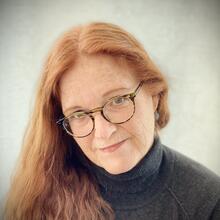The first atomic bomb was dropped on the city of Hiroshima on my mother’s 14th birthday: Aug. 6, 1945. My mother, who lived to celebrate another 70 birthdays, did not appreciate the yearly reminder that President Truman had chosen her birthday as the day to unleash hell on the world.
Since Aug. 6 was a Monday in 1945, my mother probably did not go to Mass on her birthday. Although she grew up in a devoutly Catholic family, the feast of the Transfiguration was not a holy day of obligation.
Since 1945, however, the observance of the Transfiguration and the bombing of Hiroshima have shared this date in history. I sometimes think of Aug. 6 as the ultimate meeting of simultaneous positive and negative energy. On one hand, the Transfiguration of Jesus is described this way on the Gospel of Matthew:
After six days Jesus took Peter, James, and John his brother, and led them up a high mountain by themselves. And he was transfigured before them; his face shone like the sun and his clothes became white as light…. [A] bright cloud cast a shadow over them, then from the cloud came a voice that said, “This is my beloved son, with whom I am well pleased; listen to him” (Mt 17:1-2, 5).
Mark’s account of the Transfiguration furthers the description: “[H]is clothes became dazzling white, such as no fuller on earth could bleach them” (Mk 9:3).
And according to Luke, “his face changed in appearance and his clothing became dazzling white” (Lk 9:29).
The Transfiguration did not destroy the known world as much as transform it.
On the other hand, the dazzling atomic flash of the bomb over Hiroshima and the bombing three days later of the city of Nagasaki killed over 200,000 people and injured at least another 650,000. Survivors of the bombings have left us graphic and heartbreaking firsthand accounts of these terrible events, depicting scorched human and animal bodies and the many horrifying effects of radiation fallout. Their stories have been preserved by the Hiroshima Peace Memorial Museum and the Nagasaki Atomic Bomb Museum, among others.
In 2017, Sachiko Matsuo, who was 11 at the time of the bombing of Nagasaki, described the blast like this:
There was something like a big cloud covering the whole city, and the cloud was growing and coming up toward us. I could see nothing below. My grandmother started to cry, “Everybody is dead. This is the end of the world.”
For many, it was.
Each Aug. 6, the obliterating power of nuclear weapons and the divine glory of Jesus revealed to his disciples blaze in direct opposition to each other, and we may struggle to reconcile the cognitive clash therein.
I used to think that the Transfiguration was excessive. Why should believers need this over-the-top demonstration of heavenly glory? Wasn’t Jesus enough for his raggedy band of followers? Isn’t Jesus enough for us? But as I have gotten older, I understand the importance of that moment on the mountain because we all sometimes need a spark of splendid revelation to light up our world and invigorate our faith. An awesome display of the divinity of Jesus reminds us of the beauty and privilege of our place in God’s family.
On Aug. 6, we wrestle with the dramatic extremes of good and evil, as symbolized by the ancient glory of the Transfiguration and the utter destruction of that first atomic bomb dropped on Hiroshima.
Some historians and ethicists believe that dropping atomic bombs on Japan was an unnecessarily brutal strategy on the part of the United States. Others argue that the bomb attacks saved many more millions of lives that would have been lost on both sides had the conventional war continued. But we find consensus around the fact that the incineration of Hiroshima marked the dawn of the nuclear era in human history, heralding a deadly kind of scientific progress. The film “Oppenheimer” chronicles the life and work of J. Robert Oppenheimer, the leader of the wartime Manhattan Project. After developing the weapon that could definitively wipe out civilization and the planet, Oppenheimer reportedly referred to himself as “the destroyer of worlds.”
The Transfiguration did not destroy the known world as much as transform it. The old designation on the timeline of history—B.C. or Before Christ—made clear that after the coming of Jesus Christ, the world was forever changed. Christianity itself was transfigured first in the sight of three disciples and eventually in the eyes of all believers.
Luke’s telling of the Transfiguration also provides this foreshadowing: “And behold, two men were conversing with him, Moses and Elijah, who appeared in glory and spoke of his exodus that he was going to accomplish in Jerusalem” (Lk 9:30-31). The Transfiguration story follows Jesus’ talk of an imminent future that will include suffering and picking up crosses and the “exodus” of dying, which must not have been especially comforting for his followers to hear.
The three versions of the Transfiguration culminate in the voice of God from the heavens proclaiming delight in Jesus, the Son of God. “When the disciples heard this, they fell prostrate and were very much afraid. But Jesus came and touched them, saying, “Rise, and do not be afraid” (Lk 17:6-7). The enduring magnificence of the Transfiguration assures us that God is with us always, and that this divine proximity will help us rise above our fear.
On Aug. 6, we humans wrestle with the dramatic extremes of good and evil, as symbolized by the ancient glory of the Transfiguration and the utter destruction of that first atomic bomb dropped on Hiroshima, just as we continually contend with the noble and the sinful tendencies that reside in our human hearts. We are builders of the holy tents. Sometimes we are destroyers. But we are called every day to transfigure this world, in whatever small and shining way we can, into the kingdom of God.








